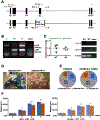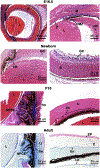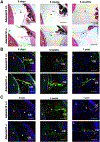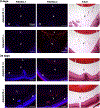Adamts10 inactivation in mice leads to persistence of ocular microfibrils subsequent to reduced fibrillin-2 cleavage
- PMID: 30201140
- PMCID: PMC8209899
- DOI: 10.1016/j.matbio.2018.09.004
Adamts10 inactivation in mice leads to persistence of ocular microfibrils subsequent to reduced fibrillin-2 cleavage
Abstract
Mutations in the secreted metalloproteinase ADAMTS10 cause recessive Weill-Marchesani syndrome (WMS), comprising ectopia lentis, short stature, brachydactyly, thick skin and cardiac valve anomalies. Dominant WMS caused by FBN1 mutations is clinically similar and affects fibrillin-1 microfibrils, which are a major component of the ocular zonule. ADAMTS10 was previously shown to enhance fibrillin-1 assembly in vitro. Here, Adamts10 null mice were analyzed to determine the impact of ADAMTS10 deficiency on fibrillin microfibrils in vivo. An intragenic lacZ reporter identified widespread Adamts10 expression in the eye, musculoskeletal tissues, vasculature, skin and lung. Adamts10-/- mice had reduced viability on the C57BL/6 background, and although surviving mice were slightly smaller and had stiff skin, they lacked brachydactyly and cardiovascular defects. Ectopia lentis was not observed in Adamts10-/- mice, similar to Fbn1-/- mice, most likely because the mouse zonule contains fibrillin-2 in addition to fibrillin-1. Unexpectedly, in contrast to wild-type eyes, Adamts10-/- zonule fibers were thicker and immunostained strongly with fibrillin-2 antibodies into adulthood, whereas fibrillin-1 staining was reduced. Furthermore, fibrillin-2 staining of hyaloid vasculature remnants persisted post-natally in Adamts10-/- eyes. ADAMTS10 was found to cleave fibrillin-2, providing an explanation for persistence of fibrillin-2 at these sites. Thus, analysis of Adamts10-/- mice led to identification of fibrillin-2 as a novel ADAMTS10 substrate and defined a proteolytic mechanism for clearance of ocular fibrillin-2 at the end of the juvenile period.
Keywords: Acromelic dysplasia; Ectopia lentis; Extracellular matrix; Metalloprotease; Weill-Marchesani syndrome; Zonule.
Copyright © 2018 Elsevier B.V. All rights reserved.
Figures





Similar articles
-
Unusual life cycle and impact on microfibril assembly of ADAMTS17, a secreted metalloprotease mutated in genetic eye disease.Sci Rep. 2017 Feb 8;7:41871. doi: 10.1038/srep41871. Sci Rep. 2017. PMID: 28176809 Free PMC article.
-
ADAMTS10-mediated tissue disruption in Weill-Marchesani syndrome.Hum Mol Genet. 2018 Nov 1;27(21):3675-3687. doi: 10.1093/hmg/ddy276. Hum Mol Genet. 2018. PMID: 30060141 Free PMC article.
-
Altered Ocular Fibrillin Microfibril Composition in Mice With a Glaucoma-Causing Mutation of Adamts10.Invest Ophthalmol Vis Sci. 2021 Aug 2;62(10):26. doi: 10.1167/iovs.62.10.26. Invest Ophthalmol Vis Sci. 2021. PMID: 34424262 Free PMC article.
-
ADAMTS proteins as modulators of microfibril formation and function.Matrix Biol. 2015 Sep;47:34-43. doi: 10.1016/j.matbio.2015.05.004. Epub 2015 May 7. Matrix Biol. 2015. PMID: 25957949 Free PMC article. Review.
-
Genetic and functional linkage between ADAMTS superfamily proteins and fibrillin-1: a novel mechanism influencing microfibril assembly and function.Cell Mol Life Sci. 2011 Oct;68(19):3137-48. doi: 10.1007/s00018-011-0780-9. Epub 2011 Aug 20. Cell Mol Life Sci. 2011. PMID: 21858451 Free PMC article. Review.
Cited by
-
Zinn's zonule.Prog Retin Eye Res. 2021 May;82:100902. doi: 10.1016/j.preteyeres.2020.100902. Epub 2020 Sep 25. Prog Retin Eye Res. 2021. PMID: 32980533 Free PMC article. Review.
-
The role of fibrillin and microfibril binding proteins in elastin and elastic fibre assembly.Matrix Biol. 2019 Nov;84:17-30. doi: 10.1016/j.matbio.2019.06.006. Epub 2019 Jun 18. Matrix Biol. 2019. PMID: 31226403 Free PMC article. Review.
-
Proteomic discovery of substrates of the cardiovascular protease ADAMTS7.J Biol Chem. 2019 May 17;294(20):8037-8045. doi: 10.1074/jbc.RA119.007492. Epub 2019 Mar 29. J Biol Chem. 2019. PMID: 30926607 Free PMC article.
-
Latent-transforming growth factor beta-binding protein-2 (LTBP-2) is required for longevity but not for development of zonular fibers.Matrix Biol. 2021 Jan;95:15-31. doi: 10.1016/j.matbio.2020.10.002. Epub 2020 Oct 9. Matrix Biol. 2021. PMID: 33039488 Free PMC article.
-
Optic neuropathy associated with TGFβ dysregulation in mice with a glaucoma-causative mutation of ADAMTS10.Matrix Biol. 2022 Nov;113:83-99. doi: 10.1016/j.matbio.2022.10.001. Epub 2022 Oct 8. Matrix Biol. 2022. PMID: 36216203 Free PMC article.
References
-
- Davis EC, Roth RA, Heuser JE, Mecham RP, Ultrastructural properties of ciliary zonule microfibrils, J. Struct. Biol 139 (2) (2002) 65–75. - PubMed
-
- Reinhardt DP, Keene DR, Corson GM, Poschl E, Bachinger HP, Gambee JE, Sakai LY, Fibrillin-1: organization in microfibrils and structural properties, J. Mol. Biol 258 (1) (1996) 104–116. - PubMed
-
- Visconti RP, Barth JL, Keeley FW, Little CD, Codistribution analysis of elastin and related fibrillar proteins in early vertebrate development, Matrix Biol 22 (2) (2003) 109–121. - PubMed
-
- Corson GM, Charbonneau NL, Keene DR, Sakai LY, Differential expression of fibrillin-3 adds to microfibril variety in human and avian, but not rodent, connective tissues, Genomics 83 (3) (2004) 461–472. - PubMed
Publication types
MeSH terms
Substances
Grants and funding
LinkOut - more resources
Full Text Sources
Other Literature Sources
Medical
Molecular Biology Databases

